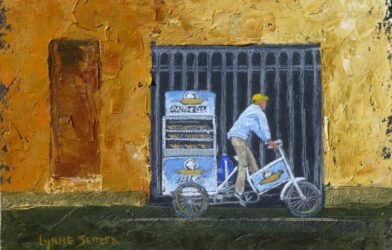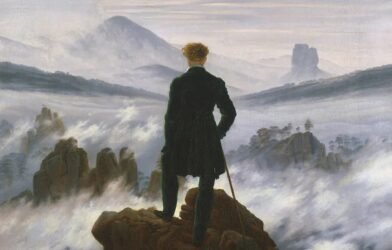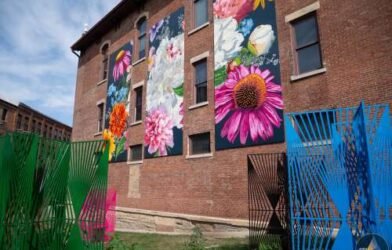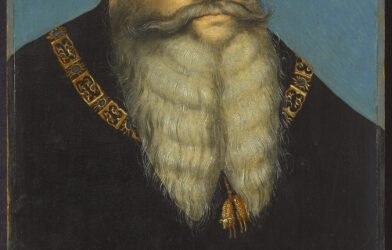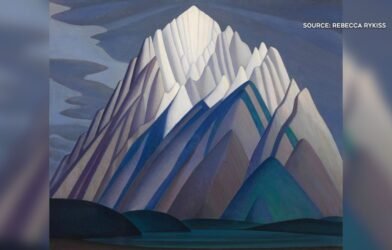A white square on a slightly different-hued white square on a larger sandy-brown square. This is Homage to the Square: Impartial by Josef Albers, painted using oil on board in 1966, one of a series of more than 1000 squares the artist created over a 25-year period. It is a pivotal work in a new exhibition, Anni and Josef Albers, at the National Gallery of Australia. The exhibition focuses on the prints and graphics of the couple, who were giants of mid-century modernism and pioneers of geometric abstraction and experimental colour theory.
It also demonstrates their significant contribution to the wider project of abstraction.
Anni and Josef Albers met as students at the Bauhaus. They were among the first to enrol – he in 1920, specialising in glass, and she in 1922, in textiles. The school was progressive in encouraging women as well as men to apply, but founder Walter Gropius backtracked after receiving more applications from women than men, capping numbers and steering women towards more “feminine” subjects, including textiles. Although Anni (born Annelise Fleischmann) was initially frustrated by the sexism that forced her into the field, she made the subject her own, ultimately becoming one of the most famous textile artists of the 20th century.
In 1925, when Josef secured a position teaching at the Bauhaus, the pair married, and Anni took a teaching position soon after. They stayed until the Nazis forced the school’s closure in 1933, making them two of the Bauhaus’s most enduring figures. Josef directed the preliminary course and was head of the carpentry workshop from 1928 to 1929, then taught drawing and lettering. In 1931 Anni was appointed head of the weaving workshop, one of the few women to hold such a senior role at the school. As part of a cohort that included famous names such as Wassily Kandinsky, Paul Klee, László Moholy-Nagy, Gropius, Marcel Breuer and Ludwig Mies van der Rohe, the experimental spirit of the Bauhaus informed their life and work. Curator Imogen Dixon-Smith writes in the catalogue that the “principles [the Alberses] absorbed … at the Bauhaus crackled like embers beneath their mature art practices”.
When the offer came to teach at the newly opened Black Mountain College in North Carolina in 1934, the couple didn’t hesitate – they had been set adrift in Berlin after the closure of the Bauhaus and were increasingly concerned about rising anti-Semitism, due to Anni’s Jewish heritage.
After arriving in America, Josef turned to painting, while Anni’s textile practice continued to flourish, with her abstract designs led by unconventional materials and techniques. At the Museum of Modern Art in 1949, her solo show was the first by a textile artist in the museum’s history and featured works made with thread, plastic, metal foil, paper, wood and cord.
In 1950, the Alberses moved to Connecticut, with Josef heading up the department of design at Yale University. This is when he began creating his squares, a project that occupied him for the next two and a half decades. In these works, each colour was painted separately on a meticulously created white background, starting with the middle square, then moving outwards in a finished painting that looks as if the colours are layered, although they are not. These colour studies also included inscriptions on their backs that carefully recorded each one’s technical details. In Connecticut, Anni continuing to weave and write, publishing the influential texts On Designing (1959) and On Weaving (1965). She also wrote at length about pre-Columbian art and architecture – the geometric motifs of these ancient cultures fascinated the couple, who travelled to Mexico 13 times, as well as to other Central and South American countries, including Peru and Chile.
In 1963, Anni began making prints and, in the same year, the Alberses met master printmaker Kenneth Tyler at the Tamarind Lithography Workshop in Los Angeles. Works from this latter period of Anni and Josef’s lives make up the majority of the work in the current exhibition. The close relationship between the Alberses and Tyler forms the heart of the show, with many of the works shown drawn from the Kenneth E. Tyler Collection and archive. Tyler, who is still alive and working in the United States today, would go on to lead the acclaimed graphic workshops Gemini G. E. L. and Tyler Graphics, becoming known for his technical prowess and ability to push the boundaries of the art form. When he met the Alberses, Tyler was still at the start of his career, but he went on to create prints for a plethora of famous artists, including Roy Lichtenstein, David Hockney and Jasper Johns.
After their first meeting, Tyler and the Alberses became kindred spirits, drawn together by a dedication to craft, technique and experimentation. Even though Anni and Josef lived on the east coast and Tyler was in Los Angeles, they corresponded by post and spoke on the telephone regularly. Josef, in particular, required exacting colour-matching for his colour studies – he was such a perfectionist Tyler began having their phone conversations transcribed. One such transcription is reproduced in the exhibition catalogue and concerns the White Line Square series, part of Josef’s continuing preoccupation with the square. For this series, Josef created the exact colours he wanted using oil pastels and cut them in half to send to Tyler so he could reproduce them exactly as prints. Each one also featured an extremely thin white line running through its colour, a detail that required perfect registration from the printmaker.
You are happy with the material I send you?
Excellent, Josef.
YOU think its promising?
Oh, I think its ver, very, promising. /////the white lines
The white lines have been a new inventioN????
Yes, and this is why I think we should put a beautiful catalogue in a show together because of it.
Anni’s prints from the same period required similar levels of technical precision and were highly experimental. By the late 1960s, she had turned completely to printmaking, selling her looms and making works that evolved from her textiles practice and drew from her research into ancient pre-Columbian patterns. Each of her Meander works uses two inks and two screens to create the illusion of four colours and four screens, for example. The three prints from this series in the exhibition – Red Meander I (1969-70), Blue Meander (1970) and Red Meander II (1970-71) – are inspired by patterns found in Oaxaca’s ancient Zapotec architecture, which the Alberses visited and photographed. Another pivotal work by Anni in this exhibition is Mountainous III (1978). Here, Tyler’s expertise comes to the fore again: the work is created not with ink, but through the embossing of a pattern. The image is created by the way the light falls across the depressions on the paper – white on white.
Although the exhibition Anni and Josef Albers focuses on the work of the couple, and in particular on their work after moving to America, it also includes works by other artists. A few key pieces drawn from the National Gallery of Australia’s collection show the geometric patterns on ancient pre-Columbian artefacts that so inspired the Alberses, including a 1000-year-old Peruvian rug.
There are also works by fellow Bauhaus artists, including Australians who had a connection to the Alberses such as painter Ludwig Hirschfeld-Mack, who kept up a correspondence with the pair after they left Germany. There are photographs of buildings by architect Harry Seidler, who described studying under Josef at the Black Mountain College as the single biggest influence on his architecture practice. This influence has been highlighted by interspersing these photographs with Josef’s prints, whose repeated grid-like patterns – inspired by his early Bauhaus works in glass – create a dialogue with Seidler’s façades.
What is missing from the show, however, is the inclusion of any of Josef’s work in glass, which were so foundational to his practice, and Anni’s textile works, especially missed since they form such a large part of her practice. While the inclusion of Anni and Josef’s biographical details and works by related artists helps to round out the picture of the couple, the exhibition falls short of telling a full story of the Alberses’ life and work.
Anni and Josef Albers is showing at the National Gallery of Australia until September 22.
ARTS DIARY
CULTURE Festival of Voices
Venues throughout lutruwita/Tasmania, June 28–July 7
CIRCUS Cirque du Soleil LUZIA
Under the Big Top, Kaurna Yarta/Adelaide, until July 7
THEATRE Fourteen
Cremorne Theatre, Meanjin/Brisbane, until July 6
MULTIMEDIA Hair Pieces
Heide Museum of Modern Art, Wurundjeri Country/Bulleen, until October 6
VISUAL ART Alphonse Mucha: Spirit of Art Nouveau
Art Gallery of New South Wales, Gadigal Country/Sydney, until September 22
LAST CHANCE
THEATRE RBG: Of Many, One
Heath Ledger Theatre, Whadjuk Nyoongar Boodjar/Perth, until June 23
This article was first published in the print edition of The Saturday Paper on
June 22, 2024 as “Abstract expressions”.
For almost a decade, The Saturday Paper has published Australia’s leading writers and thinkers.
We have pursued stories that are ignored elsewhere, covering them with sensitivity and depth.
We have done this on refugee policy, on government integrity, on robo-debt, on aged care,
on climate change, on the pandemic.
All our journalism is fiercely independent. It relies on the support of readers.
By subscribing to The Saturday Paper, you are ensuring that we can continue to produce essential,
issue-defining coverage, to dig out stories that take time, to doggedly hold to account
politicians and the political class.
There are very few titles that have the freedom and the space to produce journalism like this.
In a country with a concentration of media ownership unlike anything else in the world,
it is vitally important. Your subscription helps make it possible.





